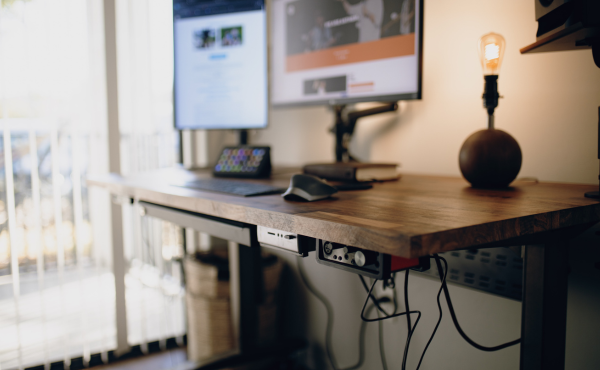
Although standing desks have been around for some time now, they are certainly not the go-to style of desk for the office despite their benefits. Standing desks or sit-to-stand workstations have been proven to have health benefits and reduce back pain while also increasing productivity making them a valuable investment for any workplace.
Health Benefits of Standing Desks
It may not be completely clear how the orientation of a desk can increase someone’s health, especially considering that in most cases users aren’t moving in either situation, however, there have been studies that have shown a standing desk can be more beneficial to users’ health than a traditional desk.
Users that stand at a desk burn more calories than those who use a traditional desk. According to an article by the Orthopaedic Hospital of Wisconsin, on average a person burns 100 - 200 calories at a standing desk versus 60 - 130 with a traditional desk. Of course at first glance this doesn’t seem like anything major, however, over an eight hour work day those extra calories burned will add up. It’s also important to note that burning more calories reduces weight gain and chances of obesity.
Standing desks also help with heart health. According to an article by Healthline, people who sit for long periods of time have an increased risk of heart disease by 147%. Standing at your workstation helps reduce this risk.
Finally, standing desks can help reduce blood sugar levels which in turn reduces the risk of blood sugar related diseases such as type 2 diabetes. According to an article by Harvard Health Publishing, there are studies that show after eating a meal people’s blood sugar levels tend to return to normal quicker if they’re standing for long periods of time rather than sitting.
Ergonomic Benefits of Standing Desks
On top of health benefits, standing desks are more ergonomically friendly than traditional desks. According to the same article by Orthopaedic Hospital of Wisconsin, standing desks promote better posture. When it comes to ergonomics it’s important to have every area covered. Monitors should be eye-level, arms should be bent at 90 degree angles, and your wrists should be resting right above the keyboard.
Proper ergonomics and posture helps reduce back, neck, and shoulder pain. In the article by Healthline, it was stated that standing desks have been proven to reduce lower back pain by 32%, and upper back/neck pain by up to 54% in just several weeks of using a standing desk. If you’re someone who experiences a lot of back, neck, or shoulder pain while working, a standing desk may just be the solution you’re looking for.
Productivity Benefits of Standing Desks
If you find yourself lacking energy after a long day of work, or if you notice you’re less productive than normal, switching to a standing desk may go a long way for you. According to Healthline, a study was conducted on the energy levels of people using standing desks over sitting desks, and the results were that 87% of the people studied said they felt increased energy levels and vigor, and felt less fatigue.
Increased energy typically results in increased productivity as well. The same article by Orthopaedic Hospital of Wisconsin said that 50% of people who worked in a call center were more productive due to standing than the other 50%. People aren’t meant to be sedentary for long periods of time, and standing up can help boost people’s moods, which as an indirect result, increases productivity as well.
Other Benefits of Standing Desks
If you aren’t convinced yet to switch to a standing desk then maybe some of these other benefits can help.
One of the main differences between an office job and other jobs is the amount of time spent at a desk rather than moving around. Getting out for a quick walk can be difficult during the workday, and in most cases people use some of their lunch break to accomplish this. Something that can help with this is a flat treadmill. These are becoming more common due to people understanding the health benefits of a standing desk, and they fit perfectly under a standing desk. These treadmills allow for people to still get their steps in while on the job, and can be easily stored underneath the desk when not in use.
According to an article by ReadWrite, standing desks can also improve your sleep. According to the article, sitting for long periods of time can create discomfort and pain which in turn makes it more difficult to sleep. Because of this, using a standing desk, which promotes a better posture, can lead to better sleep quality.
Conclusion
Standing desks have many different benefits for health, posture, and increased productivity. If you’re someone looking for a way to improve your health and energy while working, a standing desk may be the place to start. Whether you’re working remotely, or in the office, Rhyme can work with you to find a solution that works for you. If you want to browse available standing desks or sit-stand desks, click here.
If you want to learn more about standing desks, sit-stand desks, or how you can implement them into your workplace today, contact us by clicking the button below.
Sources: Orthopaedic Hospital of Wisconsin | Harvard Health Publishing | Healthline | ReadWrite